Coty “Air Spun” Powder
Loose face powders were very popular in the early part of the twentieth century. They were generally sold in boxes made from cardboard, metal or plastic and held an important place in the product line of most cosmetic companies up until the Second World War.
See also: Loose Face Powders
Commercial rivalry between cosmetic companies was fierce and a number of factors could affect the popularity of a particular brand of powder including: covering power, colouring, perfume, texture, brand name and packaging. In the 1930s, competition between American cosmetic companies heated up when Lady Esther began an advertising campaign that urged women to use the ‘bite test’ to see if their powder contained ‘grit’. As most other powders then on the market failed the bite test the campaign was very effective and Lady Esther became the most popular face powder sold in the United States.
See also: The Bite Test
The success of the bite test campaign sent many cosmetic companies looking for a manufacturing process that would enable them to improve their face powders so that they would pass the bite test and give them a fresh marketing hook that was at least as powerful as the one used by Lady Esther. In 1934, Coty secured the exclusive rights to a new manufacturing process using air-powered micronisers. This process improved Coty’s face powders and, just as importantly, gave them a new marketing angle. From now on their powders would be marketed as “Air Spun”.
Convinced that conventional ‘mechanical’ methods of face powder manufacture have reached the limit of their possibilities, Coty has uncompromisingly discarded them in favor of a revolutionary improvement—the “Air Spun” principle—which Coty found, tested, and developed.
(“Air Spun” face powder by Coty, 1935)
Air-powered micronisers
The machines that Coty secured produced a better face powder because it produced smaller powder particles that were more evenly sized and better mixed. Descriptions of the process are given below:
Purified and cold air, under very great pressure (100 lbs. per square inch) is permitted to rush in a continuous stream into a closed drum shaped chamber. This chamber, or mill, is called a ‘micronizer’ because it reduces particles to micron size (a micron is a 1/1000 of a millimeter or 1/25,000 of an inch). The speed of the air stream, the manner in which it is directed, and the shape of the chamber itself, causes air to revolve about this chamber at a rate somewhat in excess of a thousand miles per hour. In this super cyclone are caught the powder particles being fed into the chamber at a carefully controlled rate. Within the chamber, all ingredients that make up the original face powder mix are hurled over and against each other so that they reduce themselves to the desired size and fluffiness. As soon as the latter have been reached, powder particles refined to the proper degree find their way to the central exit of the circular chamber. The heavier particles are forced to remain at the circumference by their centrifugal momentum. Provided that air speed and rate of flow of the powder are kept at a pre-determined constant, which is guarded by elaborate equipment, the powder particles issuing from the “Air Spun” chamber are also of a constant size. The present particle size was selected after numerous experiments which proved it to be best for the appearance, effect and adhesiveness most desirable in a face powder. After treatment the powder is collected into bags.
(deNavarre, 1941, p. 361).
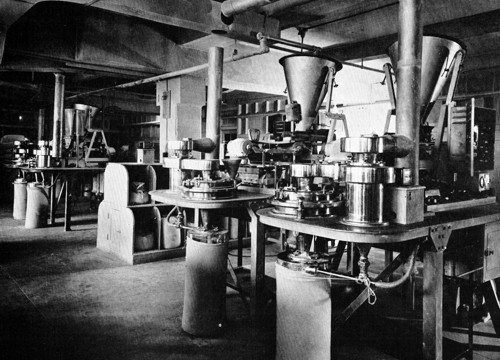
Above: 1936 Air-powered micronisers at a Coty factory.
In air floating, the finished powder is passed through a mill equipped with a fan, cyclone and dust arrester to air separate the coarser particles which cannot be blown or floated to a predetermined height, until they are sufficiently fine. A micronizer is a mill that will grind all the powder particles to the desired micron size, a micron being 0.0001 mm. or about 0.00004 in. By the air spinning process the powder is whirled around by a purified, continuous air stream under great pressure in a closed cylindrical, specially constructed metal vessel. This causes the powder particles to be knocked against one another at high speeds, estimated at over a thousand miles per hour. By this attrition the particles are reduced in size and the desired bulk is reached. At this point the smaller particles are permitted to flow from the cylinder through the use of the centrifugal force principle, while the larger ones cannot make their exit until they are divided finely enough.
The advantages of processes like these are that not only is a finer powder obtained but more uniform distribution of perfume and color is afforded and greater fluffiness is obtained.(Thomssen, 1946, pp. 58-59)
Marketing
Coty advertisements of the time strongly feature the advantages of this new technique without overwhelming the reader with a lot of technical detail.
Whatever your experiences have been with other powders … prepare to forget them when you try Coty Air Spun. For in a very real and dramatic way Coty Air Spun Powder is entirely different from any face powder you have ever used.
Where other powders are made by “mechanical methods”—by grinding and sifting—this new-type powder is spun by air. Imagine! A powder buffed by rushing torrents of air! Swirled in a fantastic snow-storm! Spun and driven until it reaches a softness and a smoothness never equaled by any other face powder.
The texture of Coty Air Spun is so smooth that the powder lies flat and even on your skin, brings a new softness to your complexion, hides tiny lines and blemishes.
The shades, spun in, look like warm, living skin tints—young and radiant. Scents are subtler and longer-lasting.
And Air Spun Powder clings longer! For it is a scientific fact that the smoother the powder, the ‘friendlier’ it is to skin texture.(Coty “Air Spun” Powder advertisement, 1935)
Coty advertisements of the period target some common consumers worries: smoothness, covering power, colour and cling. By contrasting the qualities of air and snow with conventional mechanical grinding, Coty conjured up images of a smoother, softer powder which would ‘hide tiny lines and wrinkles’, produce ‘warmer, younger shades’, ‘cling longer’ and dispensed with any notion that Coty powders might contain ‘grit’. However, in case consumers in the depression years were not totally convinced, Coty also put their Air Spun Powder in a new box, with 40% more powder than before, and dropped the price from US$1.10 to US$1.00.
First Posted: 6th March 2009
Last Update: 8th August 2024
Sources
“Air Spun” face powder by Coty. (1935). The Drug & Cosmetic Industry 37(2). 195, 200.
Appell, L. (1982). Cosmetics, fragrances and flavors: Their formulation and preparation with an introduction to the physical aspects of odor and selected syntheses of aromatic chemicals. Whiting, NJ: Novox.
deNavarre, M. G. (1941). The chemistry and manufacture of cosmetics. Boston: D Van Nostrand Company.
Thomssen, B. S. (1947). Modern cosmetics (3rd ed.). New York: Drug & Cosmetic Industry.
Toledano, R. B., & Coty, E. Z. (2009). François Coty. Fragrance, power, money. Gretna: Pelican Publishing Company.
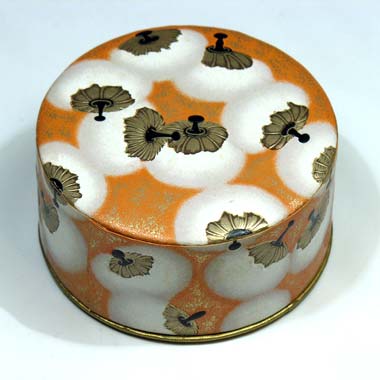
The classic Coty Powder Box developed by George Draeger from an original design by Léon Bakst.
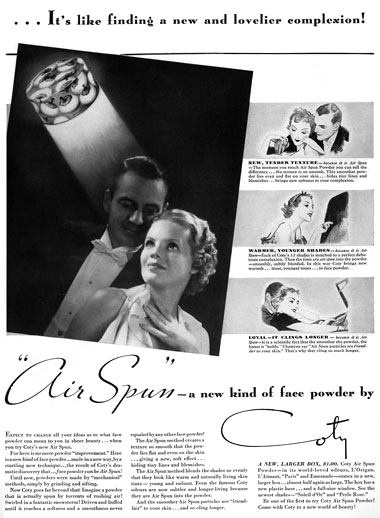
1935 Coty “Air Spun”.
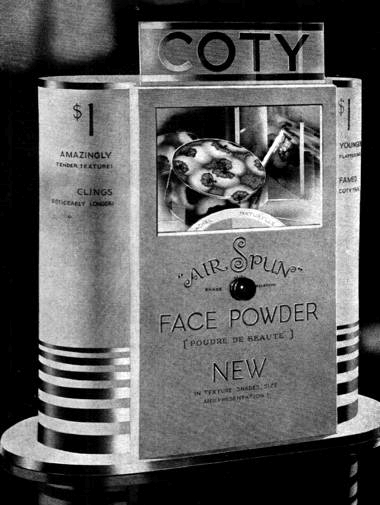
1935 A display unit for the new “Air Spun” powder. Turning the dial allows the viewer to see the different shades of powder available.
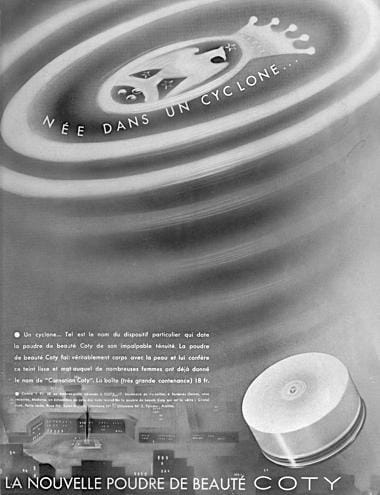
1937 Coty “Air Spun” was advertised as “Un cyclone” in France and given different packaging.
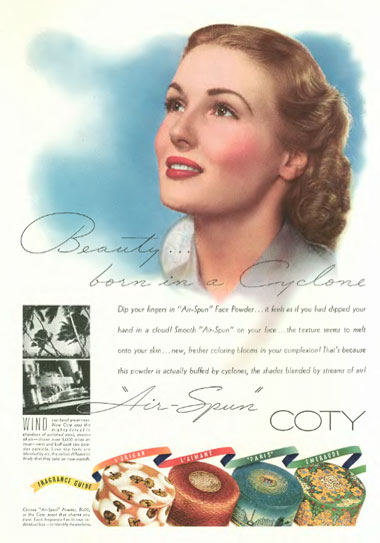
1939 Coty “Air Spun”.
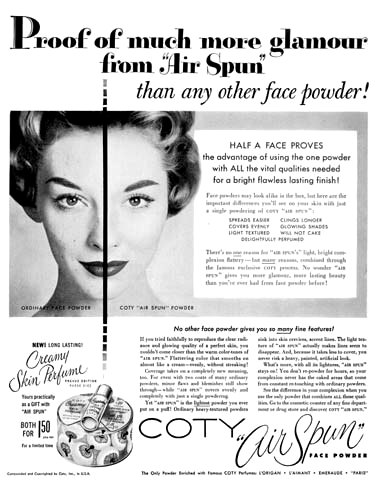
1954 Coty “Air Spun” Face Powder.
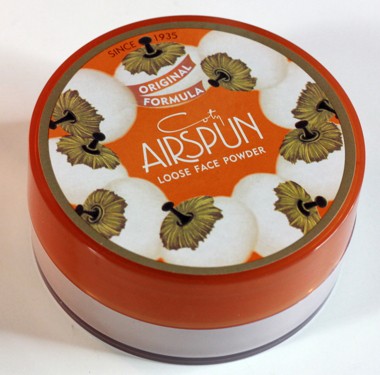
Coty “Air Spun” Loose Face Powder in modern plastic packaging.
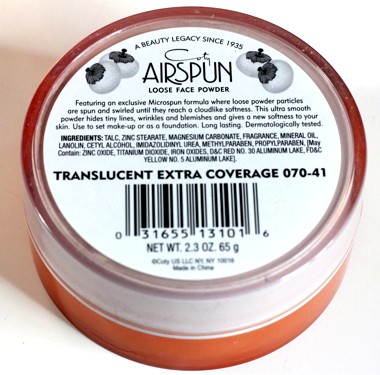
Reverse side of the modern plastic container with the ingredient list consisting of: talc, zinc stearate, magnesium carbonate, mineral oil, lanolin, cetyl alcohol, fragrance, preservatives, and colours.
